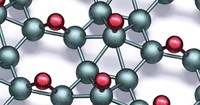Advertisement
Grab your lab coat. Let's get started
Welcome!
Welcome!
Create an account below to get 6 C&EN articles per month, receive newsletters and more - all free.
It seems this is your first time logging in online. Please enter the following information to continue.
As an ACS member you automatically get access to this site. All we need is few more details to create your reading experience.
Not you? Sign in with a different account.
Not you? Sign in with a different account.
ERROR 1
ERROR 1
ERROR 2
ERROR 2
ERROR 2
ERROR 2
ERROR 2
Password and Confirm password must match.
If you have an ACS member number, please enter it here so we can link this account to your membership. (optional)
ERROR 2
ACS values your privacy. By submitting your information, you are gaining access to C&EN and subscribing to our weekly newsletter. We use the information you provide to make your reading experience better, and we will never sell your data to third party members.
Synthesis
C&EN’s molecules of the year for 2019
Chemistry news outlet highlights the coolest compounds reported this year
by Celia Henry Arnaud
December 3, 2019
| A version of this story appeared in
Volume 97, Issue 48
Poll: What was the standout molecule of 2019?
Readers online voted on which of these molecules stood out the most this year. The winner is antiaromatic nanocage!
| Answer | Votes | Percentage |
|---|---|---|
| Antiaromatic nanocage | 316 | 29% |
| Cyclo C18 | 218 | 20% |
| C60 methane trap | 210 | 19% |
| First hexagonal planar crystal structure | 139 | 13% |
| Highly intertwined hydrocarbons | 81 | 7% |
| Twisty tetracene | 81 | 7% |
| Incredible chloride cage | 60 | 5% |
Answer: Antiaromatic nanocage
Votes: 316
Percentage: 29%
Answer: Cyclo C18
Votes: 218
Percentage: 20%
Answer: C60 methane trap
Votes: 210
Percentage: 19%
Answer: First hexagonal planar crystal structure
Votes: 139
Percentage: 13%
Answer: Highly intertwined hydrocarbons
Votes: 81
Percentage: 7%
Answer: Twisty tetracene
Votes: 81
Percentage: 7%
Answer: Incredible chloride cage
Votes: 60
Percentage: 5%

Longest, most twisted perphenylacene synthesized
Researchers at Tulane University synthesized dodecaphenyltetracene—four fused benzene rings surrounded by 12 pendant phenyl rings—in three steps. The molecule is of interest for organic electronics and photovoltaics.
Angew. Chem., Int. Ed. 2019, DOI: 10.1002/anie.201812418

Methane was caged inside C60
This year, researchers trapped methane inside C60. Methane is the first organic molecule and the largest of any kind to be trapped this way. The University of Southampton researchers made a fullerene cage with a sulfur-containing 17-membered ring, forced methane inside at high pressure, and closed the cage by oxidizing the sulfur and ejecting sulfur monoxide.
Angew. Chem., Int. Ed. 2019, DOI: 10.1002/anie.201900983
Cryptand cage had record-breaking affinity for chloride
This molecule captured and bound chloride ions using only C–H bonds, which are typically considered weak hydrogen-bond donors. The cage’s affinity for chloride is so high that the Indiana University Bloomington team that synthesized the molecule wasn’t able to isolate it without chloride.
Science 2019, DOI: 10.1126/science.aaw5145

Intertwined structures contained only benzene rings
Chemists in Japan made a trefoil knot and interlocked rings known as catenanes with nothing but benzene rings. Molecules like these typically contain heteroatoms like nitrogen. The researchers achieved this feat by adjoining nanoring fragments with silicon templates, which they cleaved off after cyclizing the fragments.
Science 2019, DOI: 10.1126/science.aav5021

New allotrope of carbon achieved
Researchers made cyclo[18]carbon, an 18-membered carbon ring with alternating single and triple bonds, by using voltage pulses from the needle tip of a scanning tunneling microscope to pick off carbon monoxide molecules from a multiring precursor.
Science 2019, DOI: 10.1126/science.aay1914
![Four structures and accompanying atomic force microscope images showing the formation of cyclo[18]carbon. Four structures and accompanying atomic force microscope images showing the formation of cyclo[18]carbon.](https://s7d1.scene7.com/is/image/CENODS/09748-cover9-panels?$responsive$&wid=700&qlt=90,0&resMode=sharp2)
First hexagonal planar crystal structure captured
The possibility of transition-metal complexes adopting hexagonal planar geometry was proposed more than 100 years ago, but the shape had never been seen in a crystal structure until this year. This rare structure consists of a palladium atom surrounded by three hydride and three magnesium-diisopropylphenyl ligands.
Nature 2019, DOI: 10.1038/s41586-019-1616-2

Antiaromatic nanocage created
Researchers made this nanocage with antiaromatic Ni(II) norcorrole building blocks, to which they added substituents and iron ions to adjust the conditions so the molecule could self-assemble into a tetrahedral shape. Molecules trapped in the cage have their nuclear magnetic resonance signals shifted downfield thanks to the cage’s unusual magnetic properties.
Nature 2019, DOI: 10.1038/s41586-019-1661-x






Join the conversation
Contact the reporter
Submit a Letter to the Editor for publication
Engage with us on Twitter